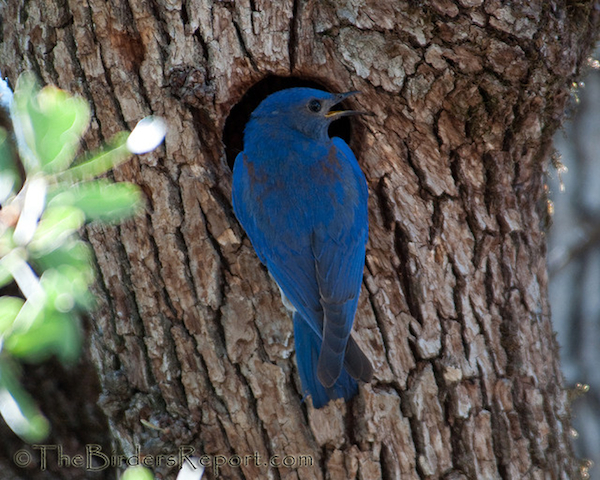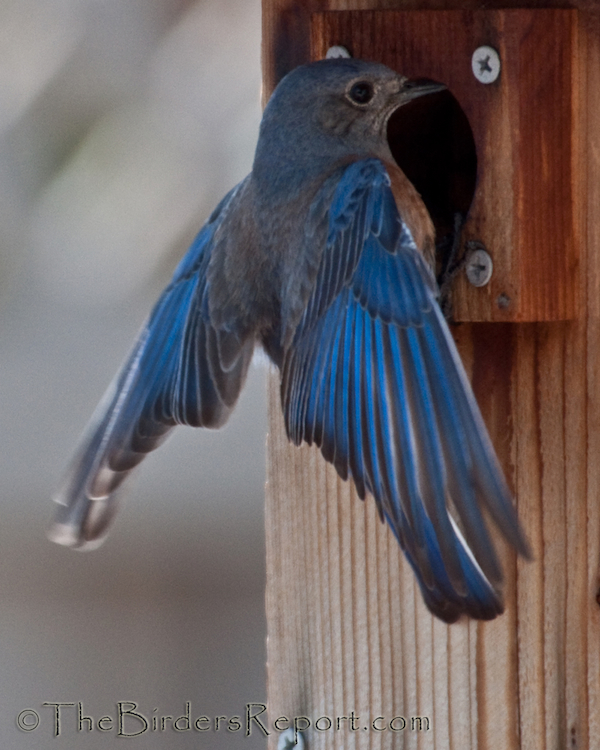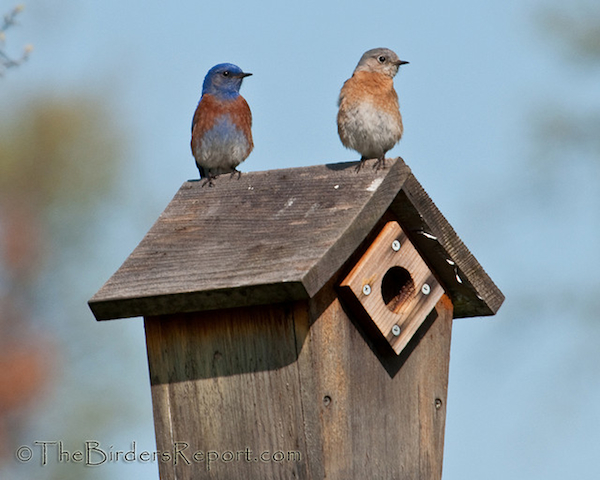Well, it is nesting season and being a nest box monitor with three Bluebird Trails, I thought I should rectify the blatant lack of coverage on 10,000 Birds of one of the most iconic North American birds of our time. Living in California, I am of course speaking of the Western Bluebird (Sialia mexicana).
The Western Bluebird, like all bluebirds, is a secondary cavity nester (more about cavity nesters in an upcoming post). They nest in cavities, created by woodpeckers, in large trees and snags. This is the male Western Bluebird checking out a natural cavity in a large oak tree (click on photos for full sized images).
Unfortunately, Western Bluebird populations have been declining because of habitat degradation (loss of suitable nest sites and foraging areas) due to extensive logging, natural-fire suppression, grazing, industrialization, and urbanization1.
Fortunately, bluebirds will also accept artificial nest boxes, which several organizations like the North American Bluebird Society and individuals across the country provide in the form of bluebird trails or backyard birdhouses. Above is the male Western Bluebird and below the female at the entrance to a nest box or birdhouse.
This entire cycle begins in early Spring when Western Bluebirds pair up for breeding. Even though they are socially monogamous, they also seek matings outside the pair bond, with the result that offspring are not always related to the attendant male1.
The pair may have to compete for nesting cavities with several other species including native Tree Swallows and Violet-green Swallows, as well as non-native House Sparrows and European Starlings. This may have also contributed to the decline in Western Bluebird numbers in the Northwest.
Like Tree Swallows, the happy couple like to stake out their nest site by perching on their chosen home.
Northern California sees Western Bluebird nest building activities beginning as early as March. The nest is a cup of dry grasses and sometimes a few feathers, built by the female, the male is occasionally seen with a blade of dry grass in his beak but his contribution is purely symbolic.
The female alone incubates the usual 4 to 6 eggs for about two weeks beginning the day the last egg is laid.
Here you can see two chicks have already hatched, one egg is split open with the chick ready to emerge and one egg has a hole in it pipped by the chick from the inside.
A couple of days later the chicks have soft gray down on their heads and along their spine but their eyes aren’t open yet, they’re just slits.
At about a week of age, the nestlings begin to open their eyes and their feather sheaths are evident.
A week later they are fully feathered, the male having brighter blue feathers than the female.
At this point, we no longer want to open the nest box as this may prompt premature fledging by the nestlings. This is one reason that if you do have nest boxes, even if it is only one birdhouse in your yard, it is important to monitor it closely and keep good records. You can download a Nest Box Monitoring Guide from my website.
The average day for young Western Bluebirds to fledge is at 21 days of age. If you know when the chicks were hatched and exactly how old they are, you may get to see their first flight from the nest.
httpv://youtu.be/2blVsU0rdxY
As you may have noticed in the video, the parents try to coax the nestlings out of the nest box by perching on nearby branches and calling to them. They also do “mock feedings’ where they act as if they are bringing food to the nest, then fly to a branch and call.
The parents continue to feed the young after fledging. For the first 3–5 days post-fledging, the young fledglings are almost completely dependent on the adults for food. After about two weeks however, they are independent and able to feed themselves.
I found these youngsters with their parents on one of my Bluebird Trails. They were old enough to feed themselves, flying down to the ground to pick on whatever they could find.
They were young enough that they were still sticking together and playing with each other.
This could be the runt with an older chick. They were fun to watch.
When dad flew by with some food, it was the youngest chick that had the biggest gape. But I didn’t see them being fed. He just flew to another tree where the chicks followed.
With the help of Bluebird Trails and backyard birdhouses and maybe a change in logging practices in the West, we can continue to see an increase in Western Bluebirds out West. They are listed as sensitive in Oregon and Utah; a candidate for listing in Washington and a species of high concern by New Mexico Partners in Flight. Western Bluebirds are also considered “in jeopardy” in California and are proposed for designation as a species of “special concern” in British Columbia1.
One of our greatest success stories in the fight to return Western Bluebirds to their native habitats occurred in Washington’s San Juan Islands where they were absent for forty years. You can read the story ” Washington Western Bluebird Reintroduction Effort a Success!” at the American Bird Conservancy’s website.
Until next time, I leave you with the late Israel Ka?ano?i Kamakawiwo?ole’s beautiful rendition of “Somewhere Over the Rainbow.” Have a great Fourth of July!
httpv://youtu.be/V1bFr2SWP1I
References:1Birds of North America Online




























they’re beautiful. i like their duskier blue shades. and the babies are adorable with their speckled chests.
@Theresa, I love my Bluebirds!
Great series!! Boom & Gary of the Vermilon River, Canada.
Great images Larry. Thanks for sharing!
@Gary thank you very much and thanks for stopping by!
@Vincent thank you. They are, after all, my favorite passerine
What a wonderful, informative post with beautiful photos!
Excellent, Larry. Spotting juvie Eastern Bluebirds is always a summer highlight for me.
@Pat thank you very much!
@Mike thanks. Someday I will see an Eastern Bluebird but for now, I guess I’ll have to be content with Western and Mountain Bluebirds 😉
They really are a splendid bird – one day I may get to see them for real!
Very good post.
Stewart M – Australia
Thank you for a great post. Very interesting and inspiring story and lovely photos, too!
beautiful series of the blue-bird Larry; it makes a wonderful story-book profile
Awesome info and photo timeline of nesting Western Bluebirds and their young. We used to see a lot more Western Bluebirds around our neighborhood, but adjacent development has destroyed habitat. Our bluebird boxes now house tree swallows & we do all we can to keep the house sparrows from taking over.
@Stewart thank you very much. If you ever come to the U.S. make sure you make time to see the Bluebirds, whether it be Western, Eastern or Mountain!
@Wendy thank you for your comment!
@Carole I think they are truly a storybook story!
@Sonia I am sorry to hear about the decline in Western Bluebirds in your neck of the woods. On one of my Bluebird Trails, where there are five ponds, I probably have as many Tree Swallows as Bluebirds but I have paired my nest boxes by placing two boxes 25 feet apart. This way, the Tree Swallows use one and the Western Bluebirds use the other and they help each other repel the House Sparrows and any other predators.
Being a non-native species, House Sparrows are not protected in the United States and they have a negative impact on Bluebird populations by taking their nesting habitat. When I find House Sparrows nesting in my nest boxes, I wait until they have a full clutch and then remove their eggs before they hatch. I have found that using this technique, the House Sparrows give up the nest box after at most two clutches and find another nesting site.
Once a male House Sparrow claims a nest box it is nearly impossible to make him relinquish his prize, therefore I never let one claim any of my nest boxes. It is better to take down the nest boxes than to allow the non-native House Sparrows to proliferate in the U.S.
I realize that some Europeans may think this is harsh treatment, especially since the House Sparrow seems to be declining in some areas in Europe, however it is the only way to prevent them from taking more cavity nesting sites from our native species other than killing them outright, which I refuse to do.
Superb shots Larry. A greatly informative post too. It’s wonderful that folk are putting up those nest boxes, but rather a shame they have to in this modern age.
@Phil thank you. I must say, without the inception of the North American Bluebird Society in 1978, Bluebirds and several other cavity nesting species would most likely be on the endangered species list or worse, no longer with us.